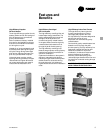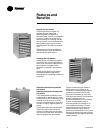
UH-PRC002-EN8
Application
Considerations
natural gas is not available, Trane units
may be ordered directly from the factory
for use on LP (propane) gas.
Gas heat content varies by fuel type and
location. The standard gross heating
value for natural gas is 1,000 Btu per
cubic foot, and for propane, 2,500 Btu
per cubic foot. Significant variations
selections. To account for variations in
the gross heating value of the fuel, adjust
the total heat input required and select
the unit on the basis of the adjusted load
using the following formula:
Adjusted load = Calculated load x
gross heat value (Btu/cu ft)
Actual gross heat value (Btu/cu ft)
Low Temperature Rise
Trane recommends against the setup of
a unit which will result in a temperature
rise of less than 30°F. With such low
temperature rises, the flue gases passing
through the heat exchanger are cooled
to condensate before reaching the flue
outlet. This condensate is corrosive and
will result in shortened heat exchanger
life.
Air Density
Catalog performance data is based on
elevations up to 2,000 feet above sea
level. Above 2,000 feet the unit’s heating
capacity must be derated four percent
for each 1,000 feet above sea level, and
special orifice selections are required.
Table PAF-1 contains correction factors
that can be applied to the unit’s
cataloged heating capacity, fan rpm, and
fan bhp to obtain actual values for
elevations above 2,000 feet.
Corrosive Atmospheres
Corrosion of heat exchangers and draft
diverters have two basic variables –
moisture (condensation) and sulphur.
These two ingredients form to make
sulfuric acid in the combustion process.
Condensation occurs commonly in
makeup air systems, using large
amounts of fresh air, when air
temperatures entering the heat
exchanger drop to 40°F or below. This
reaction can also occur in recirculating
systems where some quantity of outside
air is introduced upstream of the
exchanger. The sulphur will always be
present as an integral component of the
gas. The resulting concentration of the
acid is governed by the amount of
sulphur in the gas. This concentration
varies from gas to gas and
geographically within the same type
of gas.
Beyond sulfuric acid corrosion there is
the area of chlorinated or halogenated
hydrocarbon vapor corrosion. This type
of corrosion occurs when substances are
mixed with combustion air that will
cause the formation of hydrochloric or
hydrofluoric acid when burned. These
basic substances are found in
degreasers, dry cleaning solvents, glues,
cements, paint removers and aerosol
propellants. Specific chemicals included
in this group are trichloroethylene,
perchloroethylene, carbon tetrachloride,
methylene chloride, methyl chloroform
and refrigerants 11, 12, 21, 22 and 114.
If sufficient PPM content of these
corrosives is present, none of the
common heat exchanger materials will
hold up. The dilemma becomes whether
to place the gas heating equipment
outside of the area to be conditioned, or
use equipment in the space which does
not burn a fuel such as gas (i.e. electric or
hydronic).
Units should not be installed in areas
with corrosive or inflammable
atmospheres. Locations containing
solvents or chlorinated hydrocarbons
will produce corrosive acids when
coming in contact with burner flames.
This reaction will greatly reduce the life
of the heat exchanger and may void the
warranty. For added protection against
heat exchanger corrosion, optional 409
and 321 stainless steel construction is
available. On units using outside air, with
entering air temperature below 40°F,
condensation of flue gas in the heat
exchanger is possible. In these cases,
stainless steel heat exchangers are
recommended.
Careful review of the job application with
respect to use, probable contaminants
within a conditioned space or the
amount of fresh air to be brought in, will
help to make the proper selection of heat
exchanger material. This review will help
to eliminate problems before they begin.
NOTE: When installing duct furnaces in
parallel or in series, minimum clearance
requirements must be considered. This is
required for serviceability of the gas
valve and the high limit. “All duct
furnaces are approved in blow-thru
applications only.”
All duct furnaces are AGA approved
upstream or downstream of the cooling
coil. Recommend optional field installed
drain pan when installed on the
downstream side of the cooling coil.
NOTE: Downstream denotes cooling coil
ahead of the fan section.
When used in conjunction with filters,
cooling coils and an air handler, the duct
furnace can become part of a built-up
heating and cooling system.
Gas Heating Value
The majority of gas heating units are
installed in applications where natural
gas is readily available. In areas where
General
Propeller fan unit heaters and centrifugal
fan unit heaters are designed for use in
space heating applications. The units are
typically used in areas with high ceilings,
and are exposed in the space to be
heated. Unit heaters offer low installed
cost, and are able to heat large volume
areas without requiring extensive duct
systems.
Duct furnaces are designed for use in
ducted applications with a separate air
handling device such as a horizontal
blower assembly. By utilizing a separate
air source, greater application flexibility
in airflow delivery can be obtained.
Multiple duct furnaces can be used with
an air handling unit to provide zone
heating.


















